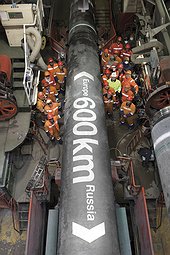Nord Stream Passes Half-Way Mark for Line 1
- More than 600 Kilometres of First Pipeline Laid in Waters of Five Countries
- 30 Ships Working on the Project at any one Time
- Benchmark for International Collaboration and Meticulous Planning
Nov. 17, 2010 | Zug | Nord Stream has now completed over half of the first of its two 1,224 kilometre gas pipelines through the Baltic Sea. The construction of Line 1 is progressing on schedule, and it will start transporting gas from Russia to customers in the European Union in late 2011.
Using up to three pipelay vessels and a flotilla of support ships, the Nord Stream consortium’s partners have constructed and laid more than 600 kilometres of pipe along different sections of the route agreed by the five countries through whose waters the large-diameter pipeline will pass.
“Everything is going according to plan, and we are on budget and on schedule,” said Nord Stream’s Managing Director Matthias Warnig. “This has been made possible by exemplary teamwork and collaboration among our many partners and suppliers across Europe and in Russia. The meticulous plans which we agreed with governments throughout the Baltic Sea region are becoming a reality, and we are carefully monitoring every step to make sure that the pipeline meets high quality, safety and environmental standards,” Mr Warnig added. “The success of our project will make it a benchmark for international collaboration and meticulous planning.”
Smooth-running Construction Programme
Saipem’s Castoro Sei pipelay vessel started construction in April in the Swedish Exclusive Economic Zone (EEZ) off Gotland, laying pipe in an easterly direction into Finnish waters before laying down the pipe and moving on to Russian waters, where it laid sections of both pipelines and participated in the shore-pull at Portovaya Bay, near Vyborg.
The main contractor’s vessel Castoro Sei then moved south to pick up another section of the first pipeline in German waters where Saipem’s flat-bottomed Castoro Dieci had completed ahead of schedule the difficult 27 kilometres shallow-water section of both pipelines at the German landfall.
Meanwhile at the other end of the 1,224 kilometre pipeline route the world’s largest pipelay vessel, Allseas’ 300 metre long Solitaire, has reached the Finnish EEZ after laying a key section in Russian waters. It had picked up the pipe where Castoro Sei had completed the first 7.5 kilometres in the Russian landfall section.
“The meticulous planning of every aspect of this complex project – technical, logistic, safety, environmental and operational – has made for a smooth-running construction programme,” says Nord Stream’s Deputy Director Construction Ruurd Hoekstra.
“At any one time at least 30 ships are working on the project in different parts of the Baltic Sea and everything is fitting into place. If anything our plans were conservative: It turned out that Castoro Dieci did not need all of the time that we had allowed for it to complete the shallow-water German landfall section, and it was demobilised four weeks earlier than originally planned,” he added.
Saipem’s Special Projects Director Guido Giorgi stated that “this unique milestone achievement is also the result of a complex but highly efficient preparation and installation engineering process that was carried out in parallel with the design phase of the pipeline. Another exceptional result of this efficient process was the optimal performance of the vessels’ spreads that completed the Russian and the German shore approaches, two vital elements of the whole pipeline installation process, ahead of schedule.”
Nord Stream’s twin pipelines will be 1,224 kilometres long and consist of altogether 202,000 concrete weight coated pipes, each 12 metres long and weighing 23 tonnes on average. When both lines are completed in 2012, they will transport 55 billion cubic metres of natural gas per year – enough to meet the needs of more than 26 million European households.
The 7.4 billion euros Nord Stream project, which is privately financed, is the most advanced of the major new gas pipelines which the European Union will need to meet its energy and climate protection targets over the coming decades.





